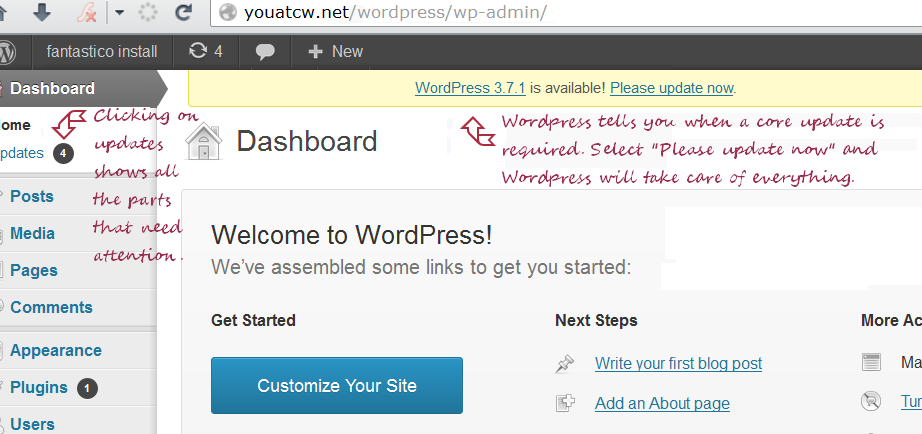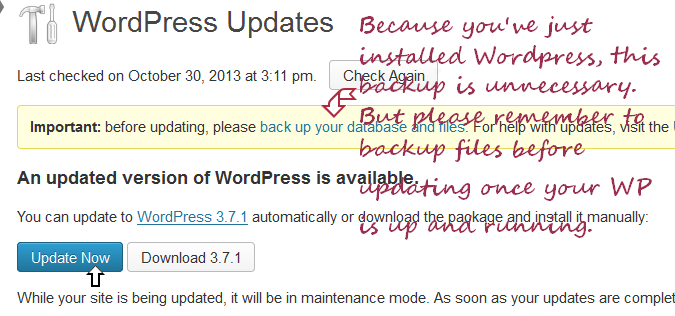WP Manual Installation: 1b. Create config file and upload WordPress to your website
Now that you have created your database, you’re ready to install WordPress on your website. (Please see create database if you haven’t yet done that.)
Download the latest stable version of wordpress to your desktop. Unzip it.
Open wp-config-sample.php in a text editor (notepad). Save it as wp-config.php. Now look for the following:
/** The name of the database for WordPress */
define('DB_NAME', 'put_your_database_name_here');
/** MySQL database username */
define('DB_USER', 'put_your_username_here');
/** MySQL database password */
define('DB_PASSWORD', 'put_yourdatabasepassword_here');
/** MySQL hostname */
define('DB_HOST', 'localhost');
If you neglected to keep a copy of the database names and password, you can find them by logging into your CPanel and selecting the MySQL Databases.
You will have to change each of the parts that are in bold. Definitely, use “copy and paste” when creating your config.php The database host (along with the other database names you need) is listed under “databases” in your account.
Please remember that passwords and names ARE case sensitive.
Once you have made the changes, save your newly created “wp-config.php” and place it in your wordpress folder in the same spot as “wp-config-sample.php”.
Upload all the WordPress files (with the exception of the now unnecessary “wp-config-sample.php”) to your wordpress folder on your website. Ensure that images, videos, media files are uploaded via BINARY and all other files (.php, .js, .txt, .htaccess, .html, .css) are uploaded via ASCII.
If you have uploaded wordpress to a folder called “wordpress”, go to
http://your-crosswinds-sitename.net/wordpress/
and wordpress will begin the installation.
Please remember to move the wordpress folder on your desktop into a backup folder on your computer.
You can now go ahead to finish the installation by following the instructions on the page. You’ll soon be ready to start using your wordpress.
- When you are prompted to enter your username, you may see “Admin”. Immediately change this! For your security, you should NEVER use the username “Admin”, “Administrator”, your website name, your website username, or your own name.
- It’s a good idea to ensure from the outset that your password is secure. Never, under any circumstances, tell anyone else your password. Nor should you ever recycle other passwords.
It is essential that your Admin password is secure; here is an example of how to create a secure password: 2or3nos+CaPs+sp3llimgErrOrsA strong password is an important protection to help you have safer online transactions. Here are some steps to create a strong password. […]
* Make your passwords at least eight (8) [characters] long. […]
* Include a combination of at least three (3) upper and/or lowercase letters, punctuation, symbols, and numerals. […]
* Don’t use the same password for everything.– microsoft.com – How Secure is my Password
Please read more about secure passwords.
- Make a note of the URL of your new wordpress admin area: http://your-crosswinds-sitename.net/yourwordpressfolder/wp-admin/.
- Using WordPress Admin area, check frequently to see if you should be updating WordPress and any plugins you use to the latest versions. WordPress handily points out any needed updates. You can go to “updates” on the sidebar or choose “Please update now” to bring your WordPress up to the latest stable version.

- Please remember to backup your database and wordpress files before updating, once your WordPress is up and running. Sometimes, things go awry. (Without a backup, the fix is a nightmare. With a backup, the fix is relatively simple.)

Because WordPress is such a popular script, it is targetted by idiots who are intent on sabotaging everything they can get their sticky fingers on. For your own peace of mind, please be sure to read about – and apply – WordPress security.
(Please note that the version numbers for WP do not necessarily reflect the most stable version. Use WP’s notifications to ascertain whether you need to upgrade.)
Hope that made sense! Good luck!